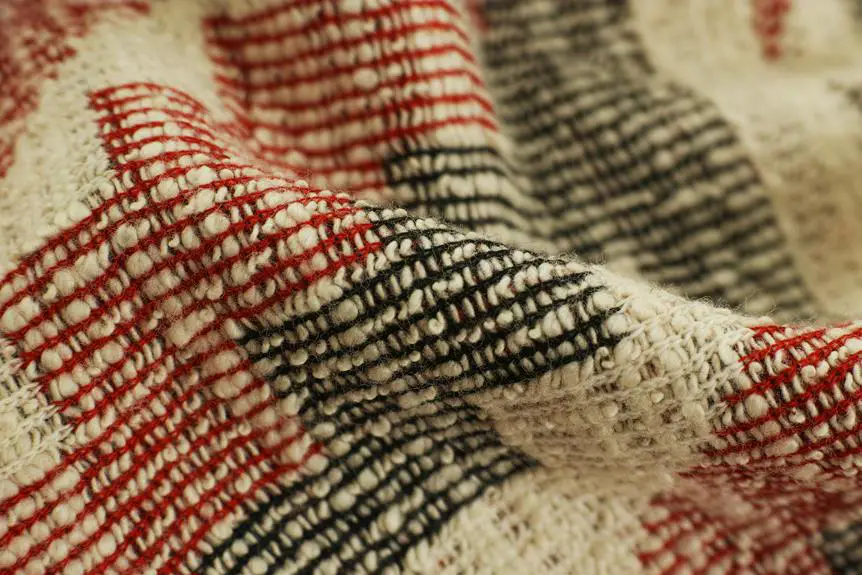You might not realize how microfleece can impact your comfort during outdoor activities, but its ability to regulate temperature is quite impressive. By trapping warm air close to your body while allowing excess heat and moisture to escape, microfleece creates a unique balance of warmth and breathability. This isn't just about staying warm; it's also about preventing the discomfort of overheating. Understanding the science behind its insulation properties and moisture management will reveal why microfleece is a go-to choice for layering in various conditions. Curious about how it compares to other fabrics?
Table of Contents
What Is Microfleece?
Microfleece is a lightweight, soft fabric that's commonly used for layering due to its excellent insulation properties. You'll often find it in jackets, blankets, and activewear.
Made from polyester, microfleece is both breathable and quick-drying, which makes it an ideal choice for outdoor activities or casual wear.
When you wear microfleece, you benefit from its cozy feel without the bulk that heavier fabrics can bring. The fabric's unique structure traps air close to your body, creating an insulating layer. This keeps you warm while allowing moisture to escape, which is essential for maintaining comfort during physical activity.
Also, microfleece is durable and easy to care for. You can toss it in the washing machine without worrying about losing its softness or shape. Its lightweight nature means you can pack it easily for travel or outdoor adventures.
The Science of Insulation
Understanding how insulation works is crucial for anyone looking to stay warm, especially in colder conditions. Insulation basically traps heat, preventing it from escaping. In simpler terms, it creates a barrier between your body and the chilly air outside. The most effective insulation materials, like microfleece, are lightweight yet effective, keeping you cozy without adding bulk.
- Material Matters: Different materials have varying capacities to trap air and retain heat.
- Layering is Key: Wearing multiple layers enhances your insulation by creating pockets of warm air.
- Fit's Important: Too tight or too loose can compromise insulation efficiency—aim for a snug but comfortable fit.
- Temperature Control: Insulated clothing reduces heat loss, but it's essential to balance warmth with the risk of overheating.
Breathability and Moisture Management
Managing moisture effectively is essential for comfort, as inadequate breathability can lead to chilling effects when you're active in cold conditions. Microfleece excels in this area, thanks to its unique structure. The fabric's fine fibers create tiny air pockets that allow better airflow while still trapping heat. This balance helps regulate your body temperature by preventing overheating.
When you're exercising or moving around, you produce sweat, and that's where microfleece really shines. It wicks moisture away from your skin and spreads it across the fabric's surface, allowing for faster evaporation. This quick moisture management keeps you dry and comfortable, reducing the risk of chills when you cool down.
Unlike heavier materials that can retain moisture, microfleece remains lightweight and breathable, making it ideal for layering. You can wear it under a shell jacket or over a base layer, depending on the climate and your activity level.
Lightweight Properties of Microfleece
When you're looking for a fabric that's both lightweight and insulating, microfleece has you covered.
Its ability to manage moisture while remaining breathable means you can stay comfortable in various conditions.
This unique combination makes microfleece an ideal choice for active wear and layering.
Insulating yet Breathable Fabric
Balancing warmth and breathability, microfleece offers lightweight comfort that's perfect for layering in varying temperatures. You'll appreciate how this fabric insulates your body without weighing you down, making it an ideal choice for outdoor activities or casual wear. Microfleece traps heat close to your skin while allowing excess warmth and moisture to escape, preventing overheating.
- Lightweight: You won't feel burdened; it's easy to wear all day.
- Versatile: Works well as a base layer, mid-layer, or standalone piece.
- Quick-drying: If you're caught in light rain or sweat, it dries rapidly.
- Soft texture: You'll love the cozy feel against your skin.
These characteristics make microfleece a favorite among outdoor enthusiasts and casual users alike. It ensures you stay comfortable, whether on a brisk hike or lounging at home. By choosing microfleece, you're investing in a fabric that adapts to your body's needs, keeping you just right in all conditions.
Moisture Management Capabilities
Microfleece excels at wicking moisture away from your skin, keeping you dry and comfortable during intense activities. This lightweight fabric is engineered to pull sweat away from your body and disperse it across the surface, allowing for quick evaporation. As a result, you maintain a pleasant temperature without feeling clammy or weighed down.
Here's a quick comparison to highlight microfleece's moisture management capabilities versus other fabrics:
| Fabric Type | Wicking Ability | Breathability |
|---|---|---|
| Microfleece | High | Excellent |
| Cotton | Low | Moderate |
| Polyester | Moderate | Good |
| Wool | Moderate | Excellent |
When engaging in high-energy exercises, you'll appreciate how microfleece keeps you feeling fresh. The moisture management not only enhances your comfort but also contributes to reducing the risk of overheating or chills. This smart design feature allows you to focus on your performance and enjoy your activities to the fullest instead of worrying about damp, heavy clothing. With microfleece, you can stay active and comfortable no matter the conditions.
Comparison With Other Fabrics
While many fabrics offer varying levels of warmth and breathability, microfleece stands out for its unique ability to regulate temperature without sacrificing comfort. When you compare it to other materials, you'll notice some key differences that make microfleece an excellent choice for active wear or cozy lounging.
- Cotton: While breathable, cotton absorbs moisture, making it heavier and cooler in damp conditions.
- Wool: Wool offers warmth and moisture-wicking properties, but can be itchy and less comfortable for many people.
- Polyester: Similar to microfleece, polyester is moisture-wicking, but it often doesn't provide the same softness and coziness.
- Down: Down insulation is warm and lightweight, but it loses effectiveness when wet, whereas microfleece remains functional.
Thanks to its unique blend of softness, breathability, and moisture management, microfleece not only keeps you warm but also offers unparalleled comfort in various conditions.
Applications in Outdoor Gear
Many outdoor enthusiasts rely on microfleece for its versatile applications in gear, providing warmth and comfort without the bulk. You'll find microfleece in jackets, pullovers, and base layers, making it an essential part of your outdoor wardrobe.
Its lightweight nature allows for easy layering, ensuring you're warm during chilly hikes or cold-weather camping trips.
When you're engaging in high-energy activities like skiing or snowboarding, microfleece works to wick moisture away from your skin. This moisture management keeps you dry and comfortable, preventing that dreaded chill when sweat evaporates.
Additionally, when paired with windproof or waterproof outer layers, microfleece plays a crucial role in maintaining your body temperature, allowing you to enjoy the outdoors for longer periods.
Microfleece also excels in versatility, fitting into a range of outdoor activities. Whether you're trekking through the woods, hitting the slopes, or just enjoying a bonfire, its adaptability means you can focus on your adventure rather than your clothing.
Care Tips for Longevity
To keep your microfleece gear performing well for years, following some simple care tips will make a significant difference. Microfleece is known for its softness and functionality, but improper care can reduce its effectiveness and longevity.
- Wash in Cold Water: Use a gentle cycle and cold water to avoid damaging the fabric. Hot water can cause microfleece to pill or shrink.
- Avoid Fabric Softeners: These can clog the fibers, reducing breathability and moisture-wicking properties. Stick to mild detergents.
- Air Dry When Possible: If you can, skip the dryer. Air drying helps maintain the shape and softness of microfleece, preventing any potential shrinkage.
- Store Properly: Keep your microfleece items in a cool, dry place, away from direct sunlight to prevent fading and degrading.
Frequently Asked Questions
Can Microfleece Help Regulate Temperature in Humid Climates?
Yes, microfleece can help regulate temperature in humid climates. It wicks moisture away from your skin, allowing sweat to evaporate quickly, keeping you cooler and more comfortable even when humidity levels rise.
Is Microfleece Suitable for Layering in Cold Weather?
Yes, microfleece is perfect for layering in cold weather. It's lightweight, traps warmth, and offers breathability, so you won't feel overheated. Just throw it on under a jacket, and you'll stay cozy throughout the day.
How Does Microfleece Compare to Wool for Temperature Regulation?
When you compare microfleece to wool for temperature regulation, you'll find microfleece offers warmth and moisture-wicking, while wool excels at insulation and breathability. Both have their benefits, so choosing depends on your specific needs.
Can Microfleece Retain Heat When Wet?
Microfleece doesn't retain as much heat when wet compared to other materials. While it provides warmth and dries quickly, moisture can reduce its insulation properties, so you're better off wearing something else if you expect to get soaked.
Are There Eco-Friendly Microfleece Options Available?
You'll find eco-friendly microfleece options made from recycled materials or organic fibers. Brands are increasingly focused on sustainability, so you can enjoy warmth and comfort without harming the environment while you stay stylish and cozy.
- How Does Ring Spun Cotton Affect Garment Fit and Shape Retention? - August 13, 2024
- What Are the Challenges in Producing Ring Spun Cotton? - August 13, 2024
- Is Ring Spun Cotton Suitable for Plus-Size Clothing? - August 13, 2024







